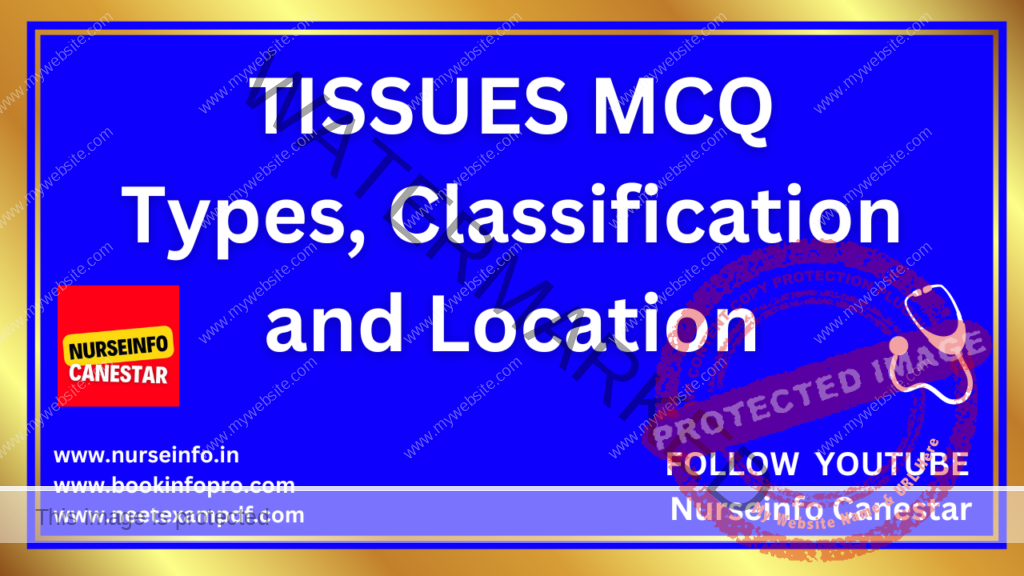MCQ ON TISSUES (Types, Characteristics, Classification and Location)
Frequently Asked MCQ quiz on Tissues – MCQ Quiz for Competitive Exam Preparation
These questions given will be useful for competitive exams preparation. We will be updating more mcq regularly, please follow our website regularly.
Tissues are groups of similar cells that work together to perform a specific function. In multicellular organisms, tissues are organized into various types based on their structure, function, and location within the body.
What type of tissue lines the inner surfaces of blood vessels and the heart?
A) Epithelial tissue
B) Connective tissue
C) Muscle tissue
D) Nervous tissue
Answer: A) Epithelial tissue
Which tissue is responsible for providing support and structure to organs?
A) Epithelial tissue
B) Connective tissue
C) Muscle tissue
D) Nervous tissue
Answer: B) Connective tissue
Which type of tissue is striated and responsible for voluntary movements in the body?
A) Epithelial tissue
B) Connective tissue
C) Skeletal muscle tissue
D) Smooth muscle tissue
Answer: C) Skeletal muscle tissue
What is the main function of nervous tissue?
A) Movement
B) Secretion
C) Control and coordination of body activities
D) Protection
Answer: C) Control and coordination of body activities
Which type of tissue covers and protects body surfaces and lines body cavities?
A) Epithelial tissue
B) Connective tissue
C) Muscle tissue
D) Nervous tissue
Answer: A) Epithelial tissue
What type of tissue forms tendons and ligaments?
A) Adipose tissue
B) Dense regular connective tissue
C) Loose connective tissue
D) Cartilage tissue
Answer: B) Dense regular connective tissue
Which type of muscle tissue is found in the walls of hollow organs such as the stomach and blood vessels?
A) Skeletal muscle tissue
B) Cardiac muscle tissue
C) Smooth muscle tissue
D) Striated muscle tissue
Answer: C) Smooth muscle tissue
Which tissue type is characterized by cells that are closely packed and arranged in single or multiple layers?
A) Epithelial tissue
B) Connective tissue
C) Muscle tissue
D) Nervous tissue
Answer: A) Epithelial tissue
What type of tissue forms the framework of the external ear and larynx?
A) Bone tissue
B) Cartilage tissue
C) Adipose tissue
D) Blood tissue
Answer: B) Cartilage tissue

What is the function of adipose tissue?
A) Storage of energy
B) Contraction
C) Communication
D) Support
Answer: A) Storage of energy
Which of the following is not a characteristic of epithelial tissue?
A) Avascularity
B) High regenerative capacity
C) Abundant extracellular matrix
D) Polarity
Answer: C) Abundant extracellular matrix
Connective tissue is characterized by:
A) Being highly vascular
B) High mitotic activity
C) Containing cells separated by a non-living matrix
D) Being involved in contraction and movement
Answer: C) Containing cells separated by a non-living matrix
The most abundant protein in connective tissue extracellular matrix is:
A) Collagen
B) Elastin
C) Keratin
D) Actin
Answer: A) Collagen
Nervous tissue is characterized by:
A) Being highly elastic
B) Containing neurons and glial cells
C) Containing intercalated discs
D) Being involved in voluntary movement
Answer: B) Containing neurons and glial cells
Muscle tissue is characterized by:
A) Being highly secretory
B) Containing neurons and glial cells
C) Containing intercalated discs
D) Being capable of contraction and movement
Answer: D) Being capable of contraction and movement
Which of the following is not a characteristic of skeletal muscle tissue?
A) Striated appearance
B) Involuntary control
C) Multinucleated cells
D) Voluntary control
Answer: B) Involuntary control
Cardiac muscle tissue is characterized by:
A) Striated appearance and voluntary control
B) Striated appearance and involuntary control
C) Non-striated appearance and voluntary control
D) Non-striated appearance and involuntary control
Answer: B) Striated appearance and involuntary control
The type of junctions found in epithelial tissues that provide strong adhesion between cells are called:
A) Gap junctions
B) Desmosomes
C) Tight junctions
D) Hemidesmosomes
Answer: B) Desmosomes
Adipose tissue is characterized by:
A) Large amounts of extracellular matrix
B) Being avascular
C) Having a high capacity for regeneration
D) Storing energy in the form of fat
Answer: D) Storing energy in the form of fat
Which of the following is not a function of epithelial tissue?
A) Protection
B) Secretion
C) Contraction
D) Absorption
Answer: C) Contraction
Which of the following is not a primary tissue type in multicellular organisms?
A) Epithelial tissue
B) Connective tissue
C) Muscle tissue
D) Nervous tissue
Answer: D) Nervous tissue
Epithelial tissue can be classified based on:
A) Cell shape and arrangement
B) Extracellular matrix composition
C) Presence or absence of striations
D) Contractility
Answer: A) Cell shape and arrangement
Connective tissue is classified into several types, including:
A) Adipose tissue, cartilage, and bone tissue
B) Smooth, skeletal, and cardiac muscle tissue
C) Simple squamous, stratified squamous, and pseudostratified epithelium
D) Sensory, motor, and interneuron tissue
Answer: A) Adipose tissue, cartilage, and bone tissue
Muscle tissue can be categorized into:
A) Striated and non-striated
B) Voluntary and involuntary
C) Smooth, skeletal, and cardiac
D) Axial and appendicular
Answer: C) Smooth, skeletal, and cardiac
Nervous tissue consists of:
A) Neurons and blood cells
B) Neurons and muscle fibers
C) Neurons and glial cells
D) Neurons and epithelial cells
Answer: C) Neurons and glial cells
Which type of epithelial tissue is best suited for areas subjected to friction?
A) Simple squamous epithelium
B) Stratified squamous epithelium
C) Simple cuboidal epithelium
D) Pseudostratified columnar epithelium
Answer: B) Stratified squamous epithelium
Loose connective tissue contains:
A) Abundant collagen fibers
B) Fewer cells and less matrix than dense connective tissue
C) A dense arrangement of fibers
D) Highly specialized cells such as osteocytes and chondrocytes
Answer: B) Fewer cells and less matrix than dense connective tissue
Cartilage tissue is classified based on:
A) The presence or absence of blood vessels
B) The number of cell layers
C) The arrangement of collagen fibers
D) The type of chondrocytes present
Answer: A) The presence or absence of blood vessels
Which of the following is a characteristic of smooth muscle tissue?
A) Voluntary control
B) Striated appearance
C) Involuntary control
D) Found exclusively in the heart
Answer: C) Involuntary control
Which type of muscle tissue is multinucleated?
A) Smooth muscle tissue
B) Skeletal muscle tissue
C) Cardiac muscle tissue
D) None of the above
Answer: B) Skeletal muscle tissue
Where is simple squamous epithelium primarily found?
A) Skin
B) Intestinal lining
C) Air sacs of the lungs
D) Urinary bladder
Answer: C) Air sacs of the lungs
Where is stratified squamous epithelium found in the body?
A) Stomach lining
B) Kidney tubules
C) Esophagus lining
D) Small intestine lining
Answer: C) Esophagus lining
Where is simple cuboidal epithelium typically located?
A) Respiratory tract
B) Liver lobules
C) Sweat glands
D) Blood vessels
Answer: C) Sweat glands
Where is pseudostratified columnar epithelium mainly found?
A) Small intestine lining
B) Bronchial tubes of the respiratory tract
C) Skin
D) Kidney tubules
Answer: B) Bronchial tubes of the respiratory tract
Where is transitional epithelium predominantly located?
A) Urinary bladder
B) Stomach lining
C) Esophagus
D) Small intestine
Answer: A) Urinary bladder
Where is areolar connective tissue commonly found?
A) Tendons and ligaments
B) Skin dermis
C) Bone
D) Blood vessels
Answer: B) Skin dermis
In which location would you find adipose tissue?
A) Around the heart
B) Beneath the skin
C) In bone marrow
D) In the walls of blood vessels
Answer: B) Beneath the skin
Where is hyaline cartilage primarily located?
A) At the ends of long bones
B) In the intervertebral discs
C) In the knee joint
D) In the tracheal rings
Answer: A) At the ends of long bones
Where is skeletal muscle tissue mainly found?
A) Walls of hollow organs like the stomach
B) Blood vessels
C) Attached to bones for movement
D) Heart
Answer: C) Attached to bones for movement
Where is cardiac muscle tissue located?
A) Walls of blood vessels
B) Walls of the stomach
C) Heart
D) Skeletal muscles
Answer: C) Heart
TYPES OF TISSUES
There are four primary types of tissues in most animals:
Epithelial Tissue: This tissue covers the surfaces of the body, both inside and out. It serves protective, absorptive, and secretory functions and is characterized by tightly packed cells arranged in sheets or layers.
Connective Tissue: Connective tissue provides support, structure, and framework to the body. It includes a variety of cell types embedded in an extracellular matrix composed of fibers and ground substance. Examples include bone, cartilage, adipose tissue, blood, and loose or dense connective tissues.
Muscle Tissue: Muscle tissue is responsible for producing movement in the body. It consists of cells called muscle fibers that can contract when stimulated. There are three main types of muscle tissue: skeletal muscle (voluntary movement), cardiac muscle (involuntary contraction of the heart), and smooth muscle (involuntary movement of internal organs).
Nervous Tissue: Nervous tissue is specialized for the transmission of electrical impulses and the rapid communication of information throughout the body. It is composed of neurons (nerve cells) and glial cells (supporting cells) and forms the brain, spinal cord, and nerves.
FOLLOW YOUTUBE CHANNEL FOR MORE MCQS CLICK HERE


